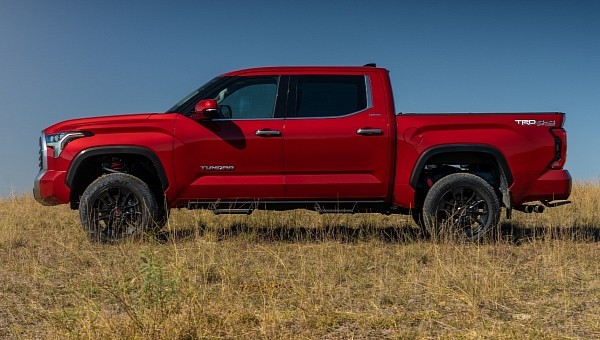In production since 2021 for the 2022 model year, the third-generation Tundra still is hampered by a plethora of issues, both large and small. On the upside, Toyota continues to address these issues, albeit mostly through technical service bulletins rather than safety recalls filed with the NHTSA.
Many owners of the 2022 to 2023 model year Tundra have complained about a pop/clunk noise on initial engine start, coming from under the half-ton pickup truck. According to technical service bulletin 0110-22, this condition affects both U.S.- and Mexico-spec vehicles. The condition usually occurs after the engine hasn’t been started for an extended period.
The remedy comes in the guise of a modification to the transmission control module’s logic. In other words, a software update should correct this problem. One day after publishing 0110-22, the Japanese automaker’s North American division published 0111-22 to address hesitation from stop and surge concerns. Once again, both 2022 and 2023 models for the American and Mexican markets are listed in the technical service bulletin.
Said concerns are split between hesitation from a complete or rolling stop, especially when the vehicle is cold, and a surge condition occurring in eighth gear with 40 to 50 percent throttle. Not surprising anyone, Toyota will remedy both concerns by updating the transmission control module.
“Born for adventure” and “driven for memories,” the V6-only Tundra is available with either a Double Cab or in CrewMax flavor. Double-cabbed trucks offer a choice between 6.5- and 8.1-foot beds, while the CrewMax makes do with 5.5- and 6.5-foot beds due to the slightly longer cabin. Seven trim levels are currently listed by the online configurator, starting with the SR at $36,965 sans freight for rear-wheel drive and the base V6.
Highlight features include a smart key system, push-button start, 18-inch steelies that can be mistaken for alloys from a few feet away, Android Auto, and Apple CarPlay. The base V6 mentioned earlier is a 3.4-liter unit rather than the 3.5 advertised by Toyota. It cranks out 348 horsepower at 5,200 revolutions per minute and 405 pound-feet (550 Nm) at 2,000 revolutions per minute, which is pretty swell for the base configuration.
The mid-range V6 levels up to 389 ponies at the same engine speed and 479 pound-feet (650 Nm) at 2,400 revolutions per minute. The i-FORCE V6 has a trick up its sleeve in the form of the i-FORCE MAX V6. The hybrid-assisted powertrain comes standard in the $68,520 TRD Pro off-road trim level and the $75,245 Capstone luxury-oriented specification.
Both of them are exclusively offered with the crew cab and 5.5-foot cargo box. Capable of 437 horsepower at 5,200 revolutions per minute and 583 pound-feet (790 Nm) at 2,400 revolutions per minute, the i-FORCE MAX V6 has the upper hand over the PowerBoost V6 of the Ford F-150. The Blue Oval-badged rival offers 430 ponies and 570 pound-feet (773 Nm).
The remedy comes in the guise of a modification to the transmission control module’s logic. In other words, a software update should correct this problem. One day after publishing 0110-22, the Japanese automaker’s North American division published 0111-22 to address hesitation from stop and surge concerns. Once again, both 2022 and 2023 models for the American and Mexican markets are listed in the technical service bulletin.
Said concerns are split between hesitation from a complete or rolling stop, especially when the vehicle is cold, and a surge condition occurring in eighth gear with 40 to 50 percent throttle. Not surprising anyone, Toyota will remedy both concerns by updating the transmission control module.
“Born for adventure” and “driven for memories,” the V6-only Tundra is available with either a Double Cab or in CrewMax flavor. Double-cabbed trucks offer a choice between 6.5- and 8.1-foot beds, while the CrewMax makes do with 5.5- and 6.5-foot beds due to the slightly longer cabin. Seven trim levels are currently listed by the online configurator, starting with the SR at $36,965 sans freight for rear-wheel drive and the base V6.
Highlight features include a smart key system, push-button start, 18-inch steelies that can be mistaken for alloys from a few feet away, Android Auto, and Apple CarPlay. The base V6 mentioned earlier is a 3.4-liter unit rather than the 3.5 advertised by Toyota. It cranks out 348 horsepower at 5,200 revolutions per minute and 405 pound-feet (550 Nm) at 2,000 revolutions per minute, which is pretty swell for the base configuration.
The mid-range V6 levels up to 389 ponies at the same engine speed and 479 pound-feet (650 Nm) at 2,400 revolutions per minute. The i-FORCE V6 has a trick up its sleeve in the form of the i-FORCE MAX V6. The hybrid-assisted powertrain comes standard in the $68,520 TRD Pro off-road trim level and the $75,245 Capstone luxury-oriented specification.
Both of them are exclusively offered with the crew cab and 5.5-foot cargo box. Capable of 437 horsepower at 5,200 revolutions per minute and 583 pound-feet (790 Nm) at 2,400 revolutions per minute, the i-FORCE MAX V6 has the upper hand over the PowerBoost V6 of the Ford F-150. The Blue Oval-badged rival offers 430 ponies and 570 pound-feet (773 Nm).










